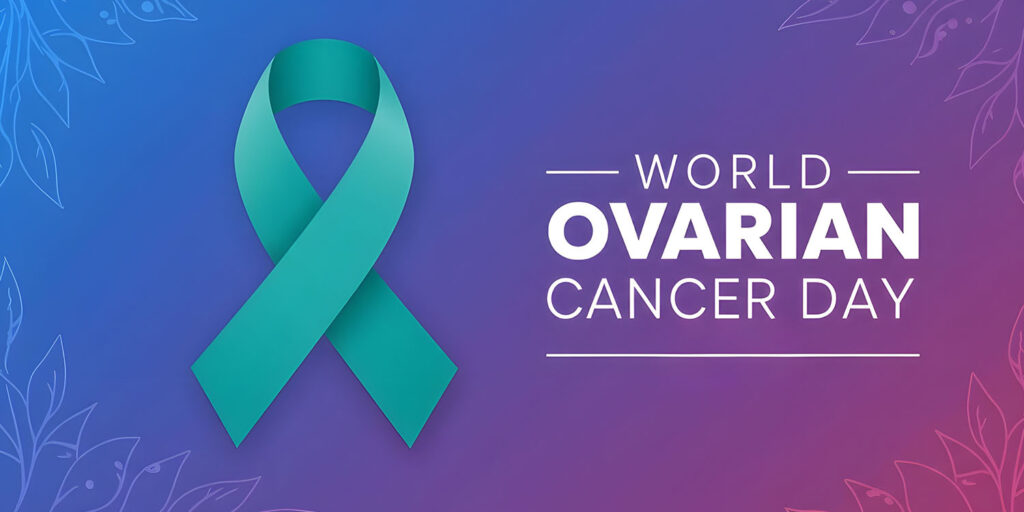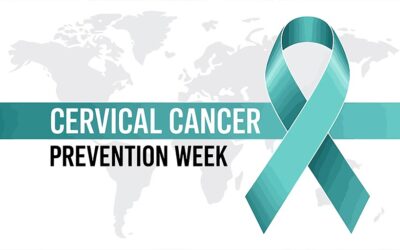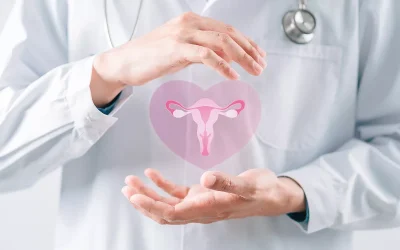World Ovarian Cancer Day 2025: Raising Awareness, Encouraging Early Diagnosis

Affecting women of all ages, ovarian cancer is one of the most challenging cancers to detect at an early stage. As a result, it often goes unnoticed until it has progressed to an advanced stage, reducing effectiveness of treatments and survival rates. World Ovarian Cancer Day, observed every year on the 8th of May, brings global attention to this silent disease, urging communities to prioritise awareness, education, and early detection. In this article we have discussed the causes, symptoms, and treatment of ovarian cancer, while also highlighting the importance of early diagnosis, key risk factors, and the role of timely medical attention in improving outcomes.
Table of Contents
ToggleImportance of Observing World Ovarian Cancer Day
Observed globally on 8 May each year, World Ovarian Cancer Day is dedicated to increasing awareness about ovarian cancer and encouraging timely diagnosis. Launched in 2013 by the World Ovarian Cancer Coalition, the day aims to unite people across the world in the fight against this under-recognised but serious disease.
Ovarian cancer is often called a “silent killer” because its early symptoms are difficult to recognise, leading to diagnosis at later stages. World Ovarian Cancer Day aims to change this by raising awareness about risk factors, warning signs, and the importance of routine medical check-ups. It also provides a platform to support those affected and promote access to better care and research.
While the theme for 2025 is yet to be officially announced, the day continues to serve as a vital reminder of the collective effort needed to improve survival rates and ensure that no woman faces ovarian cancer alone.
Understanding Ovarian Cancer
Ovarian cancer is a type of cancer that begins in the ovaries: two small organs in the female reproductive system responsible for producing eggs and hormones such as oestrogen and progesterone. It occurs when abnormal cells in the ovary grow uncontrollably and can spread to other parts of the body if not detected early.
Unlike some other cancers, ovarian cancer often develops quietly, with few or no symptoms in its early stages. As a result, it is frequently diagnosed at a later stage, making treatment more challenging. Understanding how this disease progresses and recognising its nature is the first step toward early detection and better outcomes.
Read more- PCOD 101: Understanding Symptoms, Causes, and Treatment Options
Types and Stages of Ovarian Cancer
Ovarian cancer is not a single disease but a group of cancers that originate from different types of cells within the ovary. The most common types include:
- Epithelial ovarian cancer: Arising from the surface cells of the ovary, this is the most widespread form, especially among postmenopausal women.
- Germ cell tumours: These develop from the cells that produce eggs and are more likely to affect younger women.
- Stromal tumours: A rarer type that originates from the connective tissue cells that hold the ovary together and produce hormones.
Ovarian cancer is also categorised into four stages, depending on how far it has spread:
- Stage I: Cancer is confined to one or both ovaries.
- Stage II: It has spread to the pelvis.
- Stage III: Cancer has reached the abdominal cavity or lymph nodes.
- Stage IV: The disease has spread to distant organs such as the liver or lungs.
Identifying the type and stage is essential for determining the most effective treatment plan.
Causes and Risk Factors for Ovarian Cancer
While the exact cause of ovarian cancer remains unclear, certain factors are known to increase the likelihood of developing the disease. These may be related to genetics, age, hormonal influences, and lifestyle.
Key risk factors include:
- Family history of ovarian, breast, or colorectal cancer
- Inherited gene mutations such as BRCA1 and BRCA2
- Increasing age, particularly after menopause
- Endometriosis, a condition where tissue similar to the uterine lining grows outside the uterus
- Early menstruation or late menopause
- Never having been pregnant or giving birth
- Long-term use of hormone replacement therapy (HRT)
- Obesity or lack of physical activity
Not everyone with these risk factors will develop ovarian cancer, but being aware of them can help individuals make informed decisions about screenings and preventive care.
Read more-A Comprehensive Pregnancy Diet Chart: What to Eat for a Healthy Pregnancy
Recognising the Symptoms Early
Ovarian cancer can be difficult to detect in its early stages because the symptoms are often mild, vague, or mistaken for other common conditions. However, recognising persistent signs can be vital for timely diagnosis.
Common symptoms to watch out for include:
- Ongoing bloating or swelling in the abdomen
- Pelvic or abdominal pain
- Feeling full quickly while eating
- Frequent urge to urinate
- Unexplained weight loss
- Fatigue that doesn’t go away
- Changes in bowel habits (such as constipation)
These symptoms may come and go, but when they last for several weeks or increase in severity, it’s important to seek medical advice, especially for those with a family history of ovarian or breast cancer.
Diagnosis and Prognosis
Detecting ovarian cancer early can significantly improve treatment outcomes, but it often requires a combination of tests and clinical evaluation, especially since the symptoms can be non-specific.
Diagnostic methods may include:
- Pelvic examination to check for abnormalities
- Ultrasound (transvaginal or abdominal) to visualise the ovaries
- Blood tests, such as CA-125 CA 125, CA 19.9, CEA etc. Elevated levels indicate ovarian cancer
- CT or MRI scans to assess spread or tumour size
- Biopsy (tissue sampling) to confirm diagnosis in certain cases
Once diagnosed, the prognosis depends on several factors, including the type of ovarian cancer, the stage at which it is detected, overall health, and how well the cancer responds to treatment.
Understanding the prognosis involves looking at:
- Stage of the disease: earlier stages have better outcomes
- Tumour type and grade: some grow more aggressively than others
- Response to treatment: how effectively the cancer responds to chemotherapy or surgery
- Overall health and age of the individual
Although late-stage ovarian cancer can be difficult to treat, advances in therapy and early diagnosis are gradually improving survival rates.
Ovarian Cancer Treatment Options
The treatment approach for ovarian cancer depends on several factors, including the type and stage of the disease, overall health, and patient preferences. Most treatment plans involve a combination of surgery and chemotherapy, with newer therapies emerging to improve outcomes.
Common treatment options include:
- Surgery: The primary goal is to remove as much of the tumour as possible. This may involve removing one or both ovaries, the fallopian tubes, uterus, and nearby tissues, depending on the extent of the cancer.
- Chemotherapy: Often given after surgery to kill remaining cancer cells, chemotherapy uses powerful drugs that may be administered orally or intravenously.
- Targeted Therapy: These drugs specifically attack cancer cells based on their genetic makeup, offering a more personalised treatment with fewer side effects than traditional chemotherapy.
- Hormone Therapy: In some cases, hormone-blocking treatments may be used to slow the growth of hormone-sensitive ovarian tumours.
- Radiation Therapy: Although not commonly used as a first-line treatment, radiation may be recommended in specific situations to control symptoms or treat recurrence.
The Importance of Early Detection and Regular Gynaecological Check-Ups
Ovarian cancer often develops without noticeable symptoms in its early stages, making routine health check-ups essential for timely diagnosis. When detected early, treatment is generally more effective and the chances of survival significantly improve.
Why early detection matters:
- Early-stage ovarian cancer is more likely to respond well to treatment
- It reduces the need for aggressive procedures or multiple treatment cycles
- Survival rates are considerably higher in Stage I and II compared to later stages
Significance of regular gynaecological check-ups:
- Identifying subtle symptoms that may otherwise be missed
- Monitoring risk in women with a family history or genetic predisposition
- Offering screening tests or referrals when necessary
While there is no standard screening test for ovarian cancer in the general population, regular consultations with a gynaecologist remain one of the most effective ways to stay informed and catch warning signs early.
How Graphic Era Hospital Supports Women with Ovarian Cancer
At Graphic Era Hospital, women diagnosed with ovarian cancer receive comprehensive, compassionate care backed by advanced medical expertise. The hospital’s multidisciplinary approach ensures that each patient is guided through every stage of diagnosis, treatment, and recovery with personalised attention.
What sets the care at Graphic Era Hospital apart:
- Renowned oncologists and gynaecological specialists experienced in managing complex ovarian cancer cases
- Advanced diagnostic tools and imaging facilities for accurate staging and evaluation
- Individualised treatment plans, including surgery, chemotherapy, and targeted therapies based on the latest evidence
- Supportive care services, such as counselling, nutritional guidance, and pain management, to improve overall well-being
- Collaborative care teams, ensuring continuity and coordination across departments for holistic support
From early diagnosis to post-treatment follow-up, the hospital is committed to improving outcomes and quality of life for every patient.
Call for Action on World Ovarian Cancer Day 2025
World Ovarian Cancer Day 2025 is a reminder of the urgent need to talk more openly about women’s health, especially conditions that are often overlooked. Ovarian cancer may be silent in its early stages, but through awareness, timely check-ups, and access to expert care, lives can be saved. The day brings an opportunity to encourage open conversations, support those affected, and remind communities about the importance of early detection. Whether it’s sharing information, booking a gynaecological check-up, or simply checking in with loved ones, small steps can lead to big changes.
If you or a loved one have concerns, don’t wait! Reach out to Graphic Era Hospital to consult a specialist and take a confident step towards timely, expert care.
Frequently Asked Questions
How is ovarian cancer different from cervical cancer?
Ovarian cancer starts in the ovaries, while cervical cancer begins in the cervix, which is the lower part of the uterus. They differ in symptoms, screening methods, and treatment approaches.
Can ovarian cancer be detected through a routine Pap smear?
No, a Pap smear is designed to detect cervical cancer, not ovarian cancer. Ovarian cancer often requires imaging tests and blood markers such as CA-125 for evaluation.
Is ovarian cancer hereditary?
Yes, in some cases. Mutations in genes such as BRCA1 and BRCA2 can increase the risk. Women with a strong family history of ovarian or breast cancer may benefit from genetic counselling.
Are younger women at risk of developing ovarian cancer?
While most cases occur after menopause, certain types such as germ cell tumours can affect younger women. Risk factors and symptoms should be taken seriously at any age.
Where can I find ovarian cancer treatment near me?
Graphic Era Hospital in Dehradun offers comprehensive care for ovarian cancer with a team of experienced specialists and access to advanced diagnostic and treatment facilities.
By Specialities
- Bariatric Surgery
- Cancer Care
- Cardiology
- Dental
- Dermatology
- Diabetes & Endocrinology
- Endocrinology and Diabetes
- ENT (Ear Nose Throat)
- Eye Care
- Gastroenterology
- Haematology
- Health Care
- Health Tips
- Hematology
- Hepatology
- Internal Medicine
- Mental Health and Behavioural Sciences
- Metabolic
- Neonatology
- Nephrology
- Neurology
- Nutrition & Dietetics
- Obstetrics & Gynaecology
- Oncology
- Ophthalmology
- Orthopaedics
- Paediatric
- Physiotherapy & Rehabilitation
- Plastic and Reconstructive Surgery
- Psychology
- Pulmonology
- Rheumatology
- Spine
- Urology
Recent Posts
- Cervical Cancer Prevention Week 2026: A Global Call to Prioritise Cervical Health
- Struggling with an Enlarged Prostate? Discover How Your Diet Can Help
- Knee Pain in Young Adults: Causes, Symptoms, and Treatment Options
- Most Common Lifestyle Diseases in India and How to Prevent Them
- Does Pain in the Lower Back Always Mean a Kidney Problem?
Need expert medical advice?
Share your details and our healthcare specialists will reach out to assist you.
By proceeding, you acknowledge and agree to our Privacy Policy, Terms of Use, and Disclaimer.


















